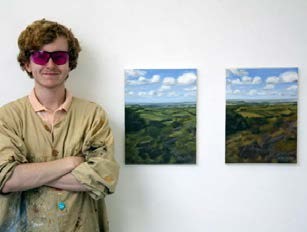Color Blind Painter Test Correction Glasses
By Celeste Beley
Most people would assume that color blindness, or color vision deficiency, or CVD, would be an issue for anyone wanting to become a painter, but modern day artist Adam Fenton does have CVD and has built a successful career in landscape paintings and color studies.
Color blindness affects millions of people and their daily lives around the world. The most common form is deutanomaly, categorized as a red-green color blindness that affects roughly 8 percent of men in the world. For Fenton, this made it difficult for him to see shades of pink, red, orange and brown. He heard about a technology called Oxy-Iso that enhances the wearer’s vision of certain colors that would normally be invisible for people with red-green color blindness.
Seeing through Rose-Colored Glasses
The glasses, developed by 2AI Labs, were created to help health-care professionals see bruises or veins beneath the skin. The concept is based on how oxygen levels in blood can change skin color and then transmit many different social signals: blushing indicates embarrassment, flushing signals anger, but these changes may also signal issues with a person’s health; hence the advantage for healthcare professionals to use these glasses.

Photo courtesy of Adam Fenton
Fenton reached out to 2AI to test the glasses. He previously used the warm hues in his paintings by learning of their effect on people, basically, painting “blind.” The Oxy-Iso lenses allowed him to see the differences between each of these hues, mostly by a glowing effect when seen through the glass. The cool colors, the blues and greens, did not look noticeably different. Fenton experimented with how the glasses affected his painting by doing a series of landscapes based on the same photograph. In Painting A, without the lenses, he realized that he used much fewer red, terracotta and sienna shades when painting, and that he mixed extra blues into the greens to make the hues even cooler and omitted adding warmer hues. In Painting B, with the Oxy-Iso lens, the fluorescent glow of the warm colors made it difficult to distinguish between red and orange, and also the cooler colors tended to look similar since they were not highlighted by the lens.
Fenton was happy to test the glasses, but sees his color blindness as an element of his own personal style, although they did allow him to pass the Ishihara test that commonly diagnoses color blindness.
“Color blindness is a condition that is diagnosable and recognized,” Fenton says. “But I think every person or every artist has their own way of seeing and they can translate that into their work.”
Extension Questions
- In what other professions would color correcting glasses be useful?
- Are there any benefits to having some type of color blindness? Where and why?

